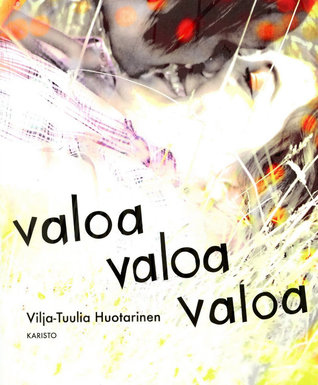An astoundingly immediate novel about painful, intoxicating, complicated adolescence.
Author: Vilja-Tuulia Huotarinen
Finnish original: Valoa, valoa, valoa
Publisher: Karisto, 2011
Genre: YA fiction
Number of pages: 211 pp.
Reading material: Finnish original, Swedish translation, English sample
Rights sold: Danish, Turbine; Swedish, Gilla böcker
It’s the summer of 1986. Frustrated, bored fourteen-year-old Mariia lives in a small town with her father, mother, and brother. Their brown house is also home to silence, as each family member processes Mariia’s mother’s illness in their own way.
The Chernobyl nuclear power plant in Ukraine has exploded, and so does Maria’s life when she meets the radiant Mimi. Mimi lives with her grandmother, aunt, and two great-uncles in a household they refer to as Mayhem. A fierce, passionate, desperate love flares up between Mariia and Mimi. Hot summer days at the beach and ’80s hits mingle with death, old age, illness, and fear of radioactive fallout.
But the girls’ lives are filled with light light light.
Vilja-Tuulia Huotarinen’s Finlandia Junior Prize-winning Light Light Light is a heart wrenching romance and a story of impossible choices made at the age of fourteen. The protagonist Mariia hates to write, so she tells her story in ways that surprise the reader and give the book depth.
“Light Light Light does not nod to its young characters from the world of adults; rather its voice comes, unaltered and alive, from a painful, head-spinning, complicated adolescence in which young people ultimately need to be protected from adults and their blindness.”
– Finlandia Junior Prize, jury statement
“Thanks to its porosity, [Light Light Light] is an easy read: fragmented, self-referential, ironic. In the hands of a literature-loving teenager who sulks attentively during language arts class, it is a work oozing with street credibility.”
– Helsingin Sanomat newspaper
“Light Light Light is a young adult novel that shakes the reader not only in terms of content but also form. In breaking from traditional narrative forms, its syntax and morphology approach both prose poetry and creative writing exercises. A pain of the sort that can only follow great happiness lives within the narrator Mariia Ovaskainen, and there’s no avoiding it. This is why the gambit of a writing course works well: writing the book actually seems to be part of Marija’s therapy.”
– Turun Sanomat newspaper
Also available:
As I Saw Them (2018)
About the author:
Vilja-Tuulia Huotarinen
